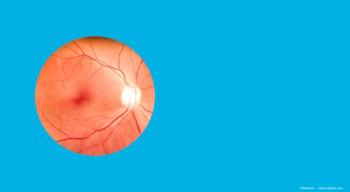
Assessing the effectiveness of netarsudil and episcleral blood flow in treatment-naive glaucoma suspects, hypertension subject
Osamah Saeedi, MD, MS, discusses his AAO 2022 talk titled, "Single-Cell Erythrocyte Tracking in Human Subjects Reveals Increase in Episcleral Venous Flow With Netarsudil 0.02%."
Video transcript
Note: This transcript has been lightly edited for clarity.
David Hutton: I'm David Hutton of Ophthalmology Times. The American Academy of Ophthalmology is holding its annual meeting this year in Chicago. I'm joined today by Dr. Osamah Saeedi, who will be one of the presenters at the podium at this year's event. Thank you for joining us today, Dr. Saeedi. Tell us about your presentation.
Osamah Saeedi, MD, MS:Thank you so much for having me, David. So my presentation is entitled, "Single-Cell Erythrocyte Tracking in Human Subjects Reveals Increase in Episcleral Venous Outflow with Netarsudil 0.02%. So that's a big mouthful, but I'll tell you about that here.
So we have developed a new way of looking at blood flow in the episcleral vessels. This actually comes off of some of our work looking at retinal blood flow. And in this new technology, what we're able to do is look at individual erythrocytes that are tagged. So patients have their blood drawn, they're tagged with the indocyanin green or ICG dye, reinjected into the patient. And then we can actually look at cells moving in the episcleral vasculature and determine the velocity, ultimately determine the change in diameter of the vessels and then look at flow rates as well.
So this is very exciting, because what it allows us to do is really characterize the distal aqueous outflow pathway. And so this is important because as you know, with aqueous humor outflow, essentially, aqueous is produced in ciliary body, it drains through trabecular meshwork, through Schlemm's canal, and ultimately into the episcleral vessels. And the episcleral vessels offer a window into aqueous humor outflow, and also allows to look at medications such as netarsudil, or Rhopressa, which can potentially modulate or change episcleral outflow.
So there had been some prior work that had looked at the reduction of episcleral venous pressure with the use of netarsudil. And so we wanted to know what is the effect of netarsudil on episcleral flow rates, both in the short term as well as in the long term.
So this is a pilot study that we did. The objective was to assess the effectiveness of netarsudil on episcleral blood flow in treatment-naive glaucoma suspects and ocular hypertension subjects, and also characterize differences in episcleral blood flow metrics between subjects.
So this is really the first time that we had characterizes in a modest group of people. And so we were able to determine the effect of certain systemic conditions and medications on episcleral blood flow, as well as then the effect of netarsudil itself.
As a prospective, unblinded, single arm cohort study, we had 10 treatment-naive patients, so they had never had any treatment for glaucoma, who are either glaucoma suspect or ocular hypertension. So we wanted to focus on the patients who would be otherwise receiving this medication. And we use this technology, erythrocyte-mediated angiography, again, where we tagged the erythrocytes to measure erythrocyte velocity. We also measured the vessel diameter with conventional ICG dye. And we then were able to determine blood flow in the episcleral vasculature at baseline, one hour after installation, one week after installation, and when we checked, and the patient was taking it continuously for a week at that point. And then when we checked that one week, we also event instilled another drop of netarsudil, and then checked again, one hour later to look at just to be able to control for short term effects.
What we found was very interesting, which was that netarsudil causes an increase in episcleral venous flow, both in terms of increase in diameter, as well as in velocity at one hour. And then that stabilizes at about one week, which makes sense. So you sort of have the initial reduction in pressure, and you have an increase in the [audio glitch], and you have an increase in flow. And then you reach a steady state after that.
And so at about a week, you end up with, you know, back to the steady state you were at before, but you now have increased capacitance of the vessels and decreased episcleral venous pressure.
So what's the significance of this work? This is really exciting, because this is the first time that we've shown that netarsudil has this other effect, we know that it has effect on the trabecular meshwork. But now, this is a downstream effect. And so what this allows us to do is think about, you know, using the tarsal, potentially as an adjunct to minimally invasive surgeries, which work on the trabecular meshwork, and to better understand who might respond to this treatment better than others; sort of more of an individualized therapy as well.
So that's the study that we're presenting, and we're certainly excited about its results and, and moving forward with this work.
Hutton: What's the next step for your research?
Saeedi: I think what we want want to do at this point is really better characterize in a larger cohort. The differences in episcleral blood flow, the effect of systemic diseases such as diabetes and hypertension, on this blood flow, and then determining who responds better, to different medications, and who--and how this might be a biomarker to determine this personalized therapy.
So, for example, if we knew that somebody's episcleral blood flow was impaired, might that be a person who was better suited to netarsudil to lower the pressure long-term?
And so that's the, that's the next step. We're also very interested in using this in conjunction with minimally invasive glaucoma surgery. So that's using this technology in conjunction with minimally invasive glaucoma surgeries to look at a good biomarker to determine even intraoperatively what patients are going to do better and how to actually adjust the surgeries intraoperatively to improve episcleral flow and ultimately lower eye pressure.
Hutton: Great, thank you so much for your time today. We really appreciate it.
Saeedi: Thank you, David.
Hutton: Thank you. Take care.
Newsletter
Don’t miss out—get Ophthalmology Times updates on the latest clinical advancements and expert interviews, straight to your inbox.









































